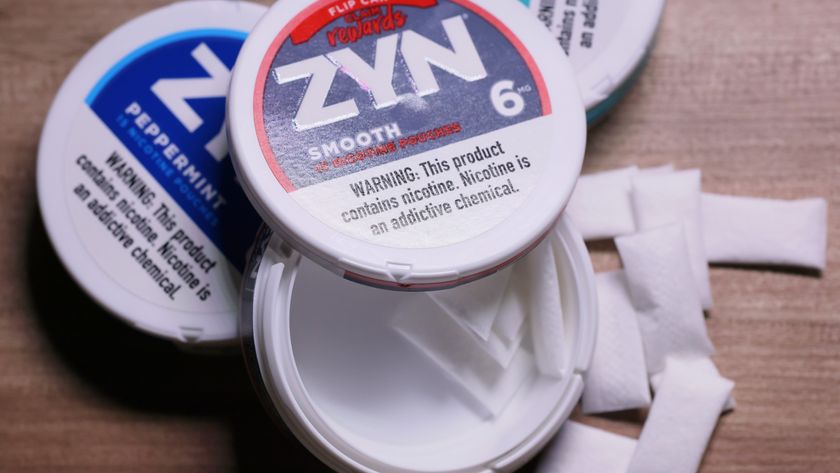New Nicotine Inhaler: A Safer Alternative to Cigarettes?

A British inventor has come up with a so-called "safe" cigarette: It's a nicotine inhaler shaped like a cigarette that delivers doses of the addictive chemical equal to those of cigarettes. Unlike the real things, though, it doesn't contain tobacco or burn when you puff it, so it doesn't pollute the lungs with carcinogenic tar.
Alex Hearn, the Oxford-educated 28-year-old who designed the product, has earned the backing of several wealthy investors as well as a licensing deal with British American Tobacco (BAT), the company behind the cigarette brands Dunhill, Kent, Lucky Strike and Pall Mall. Hearn is even in talks with the Medicines and Healthcare Products Regulatory Agency, the UK's version of the FDA, to be allowed to market his nicotine inhaler as a medicinal product. Currently under development, BAT says the inhalers will hit the market within two years.
Is the nicotine inhaler a dream come true for people who want to quit smoking — finally, a safe device that fulfills all their addictive and oral-fixative needs?
Not quite, though it holds promise.
Better of two evils
"If you need to deliver nicotine, it's certainly a safer route than what you get in a cigarette," said Scott Rogers, a University of Utah neurobiologist who studies nicotine addiction and its effects.
That said, scientists no longer think that nicotine is entirely safe. "For many years it was believed that nicotine was one of the least caustic agents in a cigarette — that it was the addiction compound but not harmful in itself," Rogers told Life's Little Mysteries. [Read: One Cigarette Can't Hurt? Think Again]
Sign up for the Live Science daily newsletter now
Get the world’s most fascinating discoveries delivered straight to your inbox.
Times have changed, however. "Nicotine has been found to influence many biological processes. For example, in can suppress the immune system," he said. "For inflammatory bowel disease [which results from an overactive immune system] this is actually good. With other diseases, it can promote problems by keeping the immune system from doing necessary work."
Nicotine is neuroprotective, Rogers explained — it keeps cells from dying.
"That's good, right? However, what if nicotine helps cells that are supposed to die survive? That's called cancer," he said. "One of the mechanisms we now recognize is that nicotine promotes certain forms of cancer growth. Tumors that should be eliminated in the lungs, for example, are not."
The effects of nicotine vary from person to person, and depend heavily on genetics; for the most part, though, most negative side effects result from long-term exposure. Using the new nicotine inhaler to wean yourself off real cigarettes would ultimately be beneficial, Rogers said. [Read: Why Is It So Hard to Quit Smoking?]
Similar products
Other devices designed to simulate tobacco smoking have been on the market for a few years now. Among them is the "electronic cigarette," a battery-powered cylinder manufactured by the Chinese company RUYAN that emits vapor when you suck it and even "lights" up. However, many people trying to ditch cigarettes have panned e-cigarettes, complaining that they don't contain sufficient nicotine to satisfy their addictions.
Furthermore, the FDA has criticized e-cigarettes for faulty manufacturing. They emit inconsistent amounts of nicotine with each puff — amounts that don't correspond to what's on the label — and have been found to contain several of the cancer-causing chemicals also found in real cigarettes. E-cigarettes are legal, however, as they do not officially fall under the regulatory purview of the FDA.
To one-up e-cigarettes, the new nicotine inhalers will have to do what their inventor and financial backers say they will. They'll need to release doses of nicotine similar to those delivered by real cigarette puffs, and the breath-activated aerosol devices in the cylinders that release that nicotine will need to work consistently. If these things happen, nicotine inhalers could be the future of quitting.
This article was provided by Life's Little Mysteries, a sister site to LiveScience. Follow us on Twitter @llmysteries, then join us on Facebook. Follow Natalie Wolchover on Twitter @nattyover.
Natalie Wolchover was a staff writer for Live Science from 2010 to 2012 and is currently a senior physics writer and editor for Quanta Magazine. She holds a bachelor's degree in physics from Tufts University and has studied physics at the University of California, Berkeley. Along with the staff of Quanta, Wolchover won the 2022 Pulitzer Prize for explanatory writing for her work on the building of the James Webb Space Telescope. Her work has also appeared in the The Best American Science and Nature Writing and The Best Writing on Mathematics, Nature, The New Yorker and Popular Science. She was the 2016 winner of the Evert Clark/Seth Payne Award, an annual prize for young science journalists, as well as the winner of the 2017 Science Communication Award for the American Institute of Physics.












